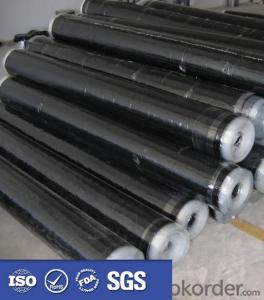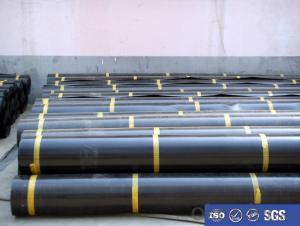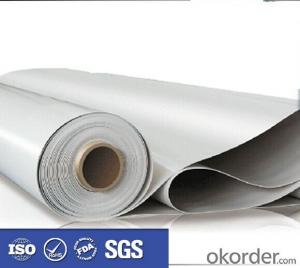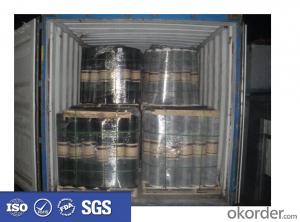EPDM Coiled Rubber Waterproof Membrane/waterproofing membrane/lastomeric waterproofing membrane
- Loading Port:
- Qingdao
- Payment Terms:
- TT OR LC
- Min Order Qty:
- 2000 m²
- Supply Capability:
- 8000000 m²/month
OKorder Service Pledge
OKorder Financial Service
You Might Also Like
Description Of EPDM Coiled Rubber Waterproof Membrane:
Self adhesive waterproof rolling material:
thickness:1.2/1.5/2.0mm
length/roll:10/20m
width/roll:1.02m
Low temperature:-15 -20,-30
Main Features of EPDM Coiled Rubber Waterproof Membrane:
1) High tear
2) High puncturing strength
3) Great temperature resistance.
4) High dimensional stability
Specifications of EPDM Coiled Rubber Waterproof Membrane:
Material | EPDM Self-adhesive Waterproof Membrane |
Size | 1.2m (width)*20m (length) or customized, weldable type 2.05m or 4m width |
Thick | 1.2mm, 1.5mm, 2.0mm |
Type | Vulcanized & Weldable |
Pattern | Non-reinforced (homogeneous) |
Certificate | ISO9001/14001 |
Applications of EPDM Coiled Rubber Waterproof Membrane:
1.It is widely used in civil and industry construction.
2.The waterproof,dampproof of the roofs,basements,toilets etc;
3.And the waterproofing of subway,underground,bridges,car parking,tunnels,reserviors,pool etc.
4.SBS modified bitumen waterproof membrane is specially suitable to the building waterproofing in cold area and to the buildings of changeable constructions
5.APP specially suitable to areas of high temperature and of strong sunshine.
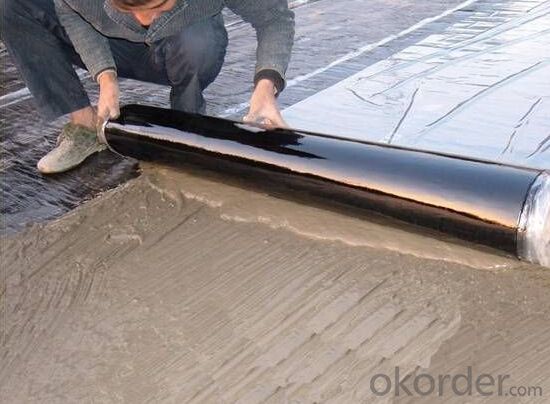


FAQ:
1. What are we supplying?
We are specialized in producing Colorful Asphalt Roof Shingle, SBS/APP modified bitumen waterproof membrane, Self adhesive bitumen waterproof membrane, PVC waterproofing membrane, EPDM rubber roofing membrane, Single Component Polyurethane Waterproof Coating, and Spray Polyurea Waterproof Coating.
2. How Many years experience do we have?
We have been exported to more than 20 countries in the past 15 years.
3. How long do we usually reply your request?
We always reply our customer within 24 hours.
- Q:Can a waterproofing membrane be used on interior walls?
- Yes, a waterproofing membrane can be used on interior walls. Waterproofing membranes are designed to create a barrier against moisture, preventing water from penetrating the surface and causing damage. While they are commonly used on exterior walls to protect against rain and groundwater, they can also be used on interior walls in areas that are prone to moisture, such as bathrooms, kitchens, or basements. By applying a waterproofing membrane, you can effectively protect the interior walls from water damage, mold growth, and other moisture-related issues. It is important to note that the specific type of waterproofing membrane and the proper installation technique should be determined based on the specific needs and conditions of the interior walls. Consulting with a professional or following manufacturer guidelines is recommended to ensure proper application and long-lasting protection.
- Q:Are waterproofing membranes resistant to alkali exposure?
- Yes, waterproofing membranes are typically resistant to alkali exposure. These membranes are designed to provide a protective barrier against water and other harmful substances, including alkalis. They are made from materials such as rubber, bitumen, or polymer-based compounds that have a high resistance to alkali. This ensures that the membrane remains intact and effective even when exposed to alkali-rich environments, such as concrete or cement surfaces. Additionally, these membranes undergo rigorous testing and are specifically manufactured to withstand alkali exposure, making them a reliable solution for waterproofing applications in various industries, including construction and infrastructure.
- Q:Can a waterproofing membrane be used for elevator shafts or equipment rooms?
- Yes, a waterproofing membrane can be used for elevator shafts or equipment rooms. Elevator shafts and equipment rooms are often exposed to moisture and water infiltration, which can lead to damage to the equipment and structural components. Therefore, it is crucial to have a reliable waterproofing solution in place to prevent water penetration. A waterproofing membrane is a commonly used method to protect elevator shafts and equipment rooms from water damage. It is a thin layer of material that is applied to the surfaces of the shaft or room, acting as a barrier against water intrusion. These membranes are typically made from various materials such as bitumen, PVC, or EPDM, which have excellent waterproofing properties. The waterproofing membrane is applied to all exposed surfaces, including walls, floors, and ceilings, to create a seamless and watertight enclosure. It is designed to withstand hydrostatic pressure and prevent water from seeping into the elevator shaft or equipment room. Additionally, the membrane can also provide protection against other forms of moisture, such as condensation. Furthermore, waterproofing membranes can be combined with other waterproofing techniques, such as sealants and drainage systems, to enhance their effectiveness. This multi-layered approach ensures a comprehensive waterproofing solution for elevator shafts and equipment rooms. In conclusion, a waterproofing membrane is a suitable solution for elevator shafts and equipment rooms, as it offers reliable protection against water infiltration. Its application creates a watertight enclosure, preventing potential damage to the equipment and structural components in these areas.
- Q:How does a waterproofing membrane work?
- A waterproofing membrane serves as a barrier applied to surfaces to prevent water infiltration and consequent damage. Typically made of flexible materials like rubber or plastic, which are water-resistant, the membrane's primary role is to establish a continuous protective layer that hinders water seepage. This is particularly crucial in areas prone to moisture, such as basements, roofs, and bathrooms. Upon application, the waterproofing membrane creates an impenetrable and seamless barrier, effectively blocking water passage. To maximize protection, it is commonly installed in multiple layers, reinforced with materials like fiberglass or polyester to enhance durability and strength. Moreover, the waterproofing membrane not only prevents water from entering surfaces but also redirects it away from the protected area. Its design encourages water flow towards designated outlets or drains, effectively channeling it away. Additionally, the waterproofing membrane exhibits resistance against moisture-related issues, such as mold and mildew growth. By obstructing water entry, it helps maintain a dry and healthy environment. Overall, the waterproofing membrane plays a crucial role in safeguarding structures and surfaces from water damage. It offers a reliable and long-lasting solution to prevent leaks, seepage, and moisture-related concerns, ensuring the integrity and longevity of the protected area.
- Q:Can a waterproofing membrane be used on sloped surfaces?
- Yes, a waterproofing membrane can be used on sloped surfaces. In fact, it is commonly used on sloped surfaces such as roofs, balconies, and terraces to prevent water infiltration and ensure effective drainage. The membrane is designed to provide a durable and flexible barrier that can accommodate the movement and incline of sloped surfaces, helping to protect the underlying structure from moisture damage.
- Q:Sbs waterproof sheet and app coil how to see it
- APP is a plastic body modified asphalt waterproofing membrane referred to, usually also known as APP modified asphalt waterproofing membrane, is a polyester felt, glass fiber mat or glass fiber reinforced polyester felt for the fetal base, random poly (APAO, APO, etc.) as a petroleum asphalt modifier, both sides covered with insulating materials made of building waterproofing membrane, product markings according to the following procedures: name, model, fetal base , The upper surface material, the lower surface material, the thickness, the area and the standard number, for example: 3mm thick, 10 square meters, the upper surface of the mineral pellets, the lower surface of the polyethylene film, polyester fetal base, Modified asphalt waterproofing membrane marked as: APP I PY M PE 3 10 GB18243-2008.
- Q:Can a waterproofing membrane be used on elevator shafts?
- Yes, a waterproofing membrane can be used on elevator shafts. Elevator shafts are prone to water infiltration, especially in areas where the water table is high or during heavy rainstorms. Installing a waterproofing membrane on the walls and floor of the elevator shaft can provide an effective barrier against water penetration. The membrane is typically made of a durable material such as bitumen or rubberized asphalt, which is applied in multiple layers to ensure maximum protection. It acts as a waterproof barrier, preventing water from seeping into the shaft and causing damage to the elevator equipment or the building structure. Additionally, the waterproofing membrane also helps to control moisture and condensation, which can lead to mold growth and other issues. Proper installation and maintenance of the membrane are crucial to ensure its long-term effectiveness in keeping the elevator shaft dry and protected.
- Q:Can a waterproofing membrane be used in bathrooms?
- Yes, a waterproofing membrane can be used in bathrooms. In fact, it is highly recommended to use a waterproofing membrane in bathrooms to prevent water damage and leakage. The membrane is typically applied on the walls and floors, creating a barrier that prevents water from seeping through and causing structural damage or mold growth. This is especially important in areas such as showers and around bathtubs where water exposure is high. Waterproofing membranes are designed to withstand moisture and provide long-lasting protection, ensuring the integrity of the bathroom and extending its lifespan.
- Q:Can a waterproofing membrane be used in kitchens?
- Yes, a waterproofing membrane can be used in kitchens. In fact, it is highly recommended to use waterproofing membranes in areas prone to moisture and water exposure, such as kitchens. These membranes are designed to create a barrier against water and prevent it from seeping into the underlying structure, protecting it from damage. They are commonly used on floors, walls, and even countertops to ensure a watertight seal and prevent water damage, mold growth, and other issues. Additionally, waterproofing membranes can also help with soundproofing and provide added durability and longevity to the kitchen surfaces.
- Q:Does a waterproofing membrane require any specific surface preparation?
- Yes, a waterproofing membrane typically requires specific surface preparation before installation. This involves cleaning the surface, removing any loose debris, and ensuring it is smooth and dry. Additionally, some membranes may require priming or the use of specific adhesives depending on the type of surface they are being applied to. Proper surface preparation is crucial to ensure effective adhesion and long-lasting waterproofing performance.
1. Manufacturer Overview |
|
|---|---|
| Location | |
| Year Established | |
| Annual Output Value | |
| Main Markets | |
| Company Certifications | |
2. Manufacturer Certificates |
|
|---|---|
| a) Certification Name | |
| Range | |
| Reference | |
| Validity Period | |
3. Manufacturer Capability |
|
|---|---|
| a)Trade Capacity | |
| Nearest Port | |
| Export Percentage | |
| No.of Employees in Trade Department | |
| Language Spoken: | |
| b)Factory Information | |
| Factory Size: | |
| No. of Production Lines | |
| Contract Manufacturing | |
| Product Price Range | |
Send your message to us
EPDM Coiled Rubber Waterproof Membrane/waterproofing membrane/lastomeric waterproofing membrane
- Loading Port:
- Qingdao
- Payment Terms:
- TT OR LC
- Min Order Qty:
- 2000 m²
- Supply Capability:
- 8000000 m²/month
OKorder Service Pledge
OKorder Financial Service
Similar products
New products
Hot products
Hot Searches
Related keywords
